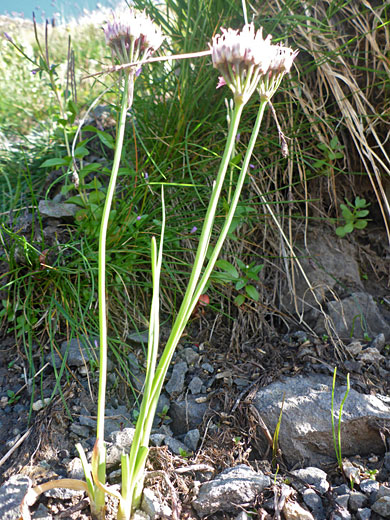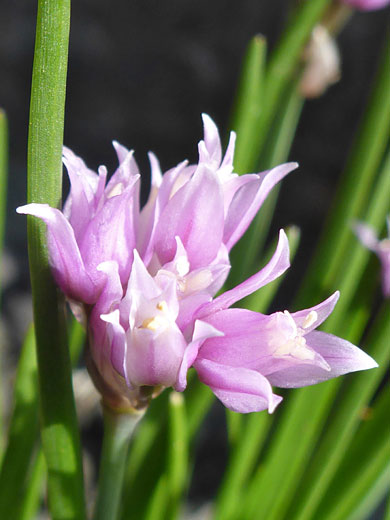
Pink flowers of allium geyeri (Geyer's onion), just beginning to open, along the Cerro Grande Trail, Bandelier National Monument, New Mexico
Common name:
Geyer's onion
Family:
Scientific name:
Allium geyeri
Main flower color:
Range:
The Pacific Northwest and the Rocky Mountain states, south to Arizona and far west Texas
Height:
Between 4 and 24 inches
Habitat:
Moist meadows, hillsides, streambanks, woodland clearings
Leaves:
Up to 2 feet long, thin, grass like - 3 to 5 leaves per stem
Season:
May to September
Geyer's onion, allium geyeri, produces a thick green stalk, which bears a few leaves only at the base, and terminates in a compact, spherical cluster of between 10 and 25 pale pink, urn-shaped flowers; these have six pointed tepals (pink to white in color), curved at the base and pointed at the tip, enclosing a style and several stamens topped by yellow anthers. Two or three thin papery bracts are found at the base of the umbel, but these wither away during flowering
The plant is found over a wide range of habitats, from woodland and low foothills to the mountain tundra zone up to 12,000 feet. Two varieties are var tenerum, which has fewer flowers (up to five); instead the umbel includes several egg-shaped bulbils (small bulbs), and var geyeri, the usual form, with no bulbils and up to 25 flowers. Both are found over the same general area.
The plant is found over a wide range of habitats, from woodland and low foothills to the mountain tundra zone up to 12,000 feet. Two varieties are var tenerum, which has fewer flowers (up to five); instead the umbel includes several egg-shaped bulbils (small bulbs), and var geyeri, the usual form, with no bulbils and up to 25 flowers. Both are found over the same general area.
All Contents © Copyright The American Southwest | Comments and Questions | Contribute | Site Map






